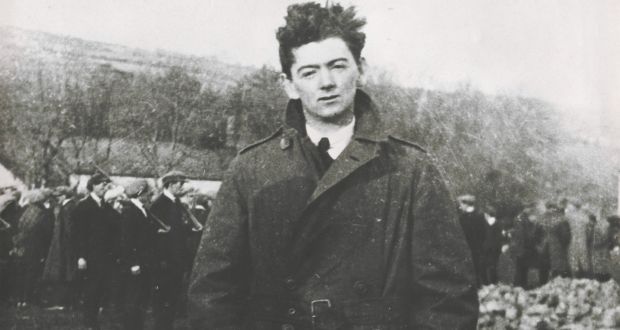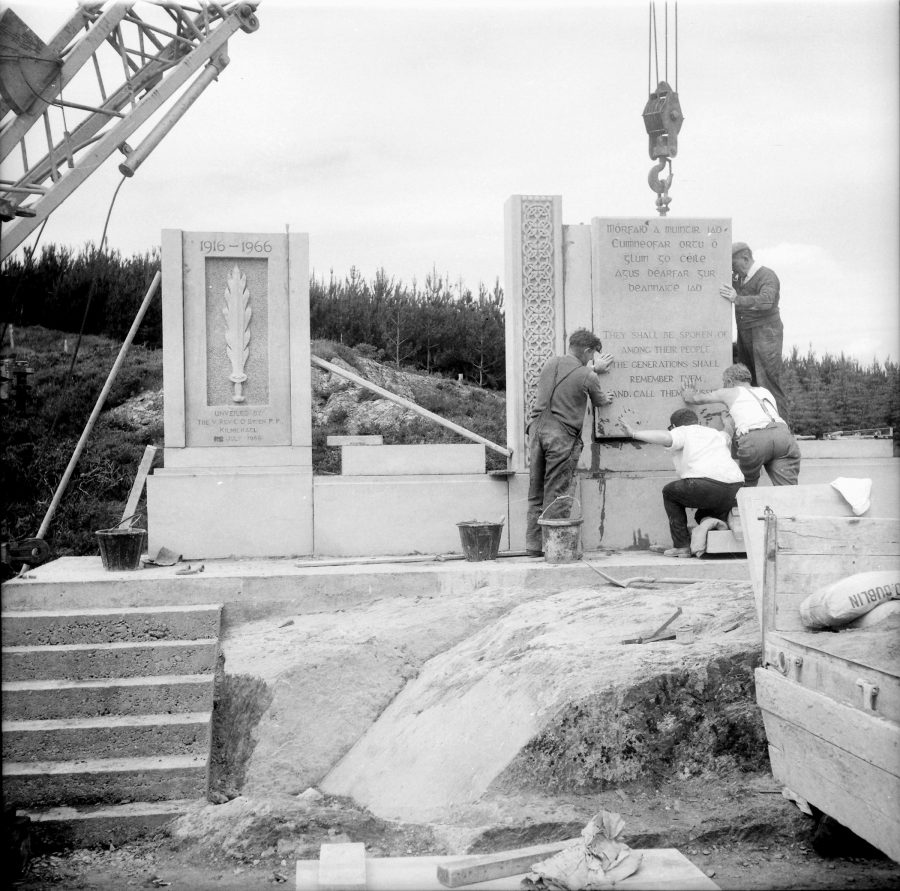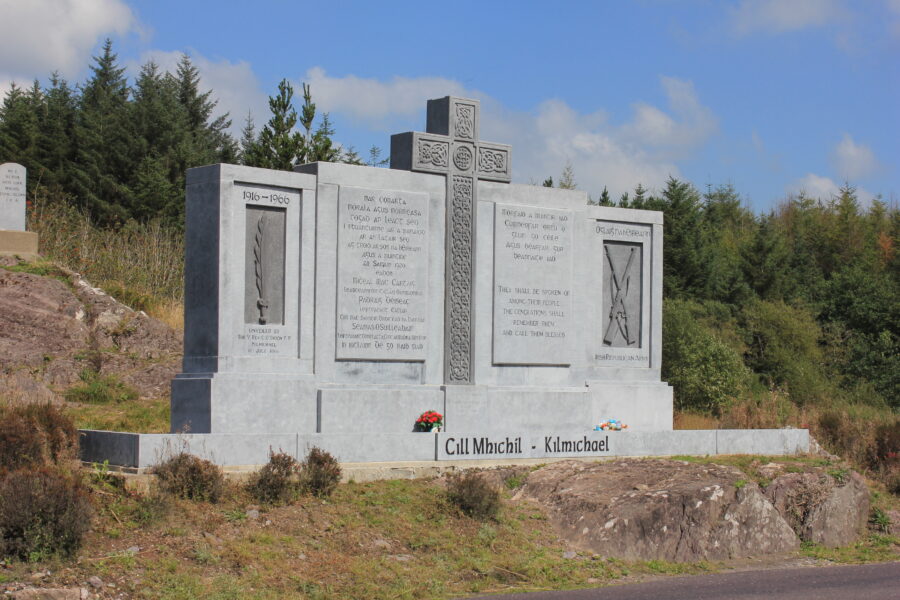
1076a. Photograph of Tom Barry, c.1920 (source: Cork City Library).
Kieran’s Our City, Our Town Article,
Cork Independent, 26 November 2020
Remembering 1920: The Kilmichael Ambush
The Kilmichael ambush site was one of several staging points of attack on British forces during the Irish War of Independence. On 28 November 1920, the Black and Tans left the town of Macroom, to be unexpectedly greeted by the Flying Column led by West Cork man and republican Tom Barry at Kilmichael. Tom had enlisted in the British Army during the First World War and served in Mesopotamia. He returned to Ireland in 1919 and became a prominent member of the Irish Republican Army during the War of Independence. The ambush area he chose was and still is in the centre of a rocky and barren landscape. A week before the ambush, men came together at nearby Clogher to be trained in guerrilla warfare tactics by General Barry.
In all seventy-five men were involved in the Kilmichael Ambush and they were from all parts of West Cork, including Dunmanway, Clonakilty, Bantry, Bandon, Ballineen, Newcestown and Coppeen. Tom Barry later penned Guerilla Days in Ireland (1949) and The Reality of the Anglo-Irish War 1919-21 (1974), which detail his own memories and perspectives on and personal role in the Irish War of Independence. In Guerilla Days in Ireland, he noted of his tactics at Kilmichael:
The point of this road chosen for the attack was one and half miles south of Kilmichael. Here the north-south road surprisingly turns west-east for one hundred and fifty yards and then resumes its north-south direction. There were no ditches on either side of the road but a number of scattered rocky eminences of varying sizes. No house was visible except one, one hundred and fifty yards south of the road at the western entrance to the position. It was on this stretch of road it was hoped to attack the auxiliaries.
As the first lorry of Black and Tans came around the turn of the road, Tom Barry, dressed in a volunteer tunic, stood facing it on the road. Because of the fading light, the British thought him to be a British Officer and slowed down. As they did, Barry blew on his whistle and tossed the mill bomb, which landed in the lorry killing the driver. The No. 1 Section dealt with those remaining in the lorry, the Auxiliaries firing shots and the Flying Column pouring lead into them. Soon, some of the Auxiliaries were on the road, the fight becoming a hand-to-hand one. The Auxiliaries in the second lorry were taken on by the No. 2 Section and soon, those in the first lorry had been defeated. Seeing this, Barry and his three companions moved along the grass verge from their post to ambush the second lorry from behind unknown to the Black and Tans.
The Kilmichael Ambush delivered a ‘profound shock’ to the British system, happening only a week after the ‘Bloody Sunday’ assassination of a dozen army officers in Dublin and days after a large section of the Liverpool docklands was burned down. Dublin and Liverpool showed British weaknesses, but Kilmichael revealed that the IRA could combat and win against British soldiers in the field. Shortly afterwards a small memorial cross was erected at the Kilmichael Ambush site.
Fast forwards to 1966, and across the country, various groups chose to celebrate the fiftieth anniversary of the 1916 Rising through various means such as parades and unveiling new memorials. Cork had the highest number of events with thirty-four recorded events.
Cork’s Southern Star newspaper (on 5 February 1966) noted that to mark the fiftieth anniversary of the Easter Rising in the Kilmichael area, in January 1965 a committee had begun working a year earlier on a new monument for the ambush site. The committee was headed up by its president, Commandant General Tom Barry (veteran leader of the ambush).
Assembling figures such as Tom Barry, in addition to well-known veterans of the West Cork Brigade of the War of Independence and others such as the local parish priest, and the local national teacher, gave weight to the representational structure of the committee. It also gave significance to the importance of the memorial and the narratives that they were involved in constructing. They included Canon Cornelius O’Brien, the local parish priest of Kilmichael and local historian, Commandant Pat O’Brien (Vice President of committee and veteran of West Cork Brigade), Tom Hales (Vice Chairman of committee and veteran of West Cork Brigade), Major Maurice Donegan (Vice President of committee and veteran of West Cork Brigade), Daniel O’Leary (treasurer), Jim Barry (representative on the Cork sub-committee), William Hales (veteran of West Cork Brigade) and Flor Crowley, local national teacher (secretary). The honorary secretary of the Kilmichael and Crossbarry memorials committee, Mr Flor Crowley, said at that unveiling that the monument was regarded as a tribute by the whole people of Ireland to the soldiers who had fought at Kilmichael and to the three men who died there and not as the tribute by any individual section of the people.
Local man Dennis Dineen took several pictures of the Kilmichael Ambush Memorial being erected in 1966. An avid photographer and entrepreneur from the nearby town of Macroom, he was also a vintner and a taxi driver. Dennis, who died in 1985, not only supplied pictures to newspapers but also photographed weddings, families, class groups, teams, and streetscapes in the region. During his career he captured many historic and iconic moments in the history of mid Cork in an effort to build up a portfolio of memories for future reflection and use.
On 10 July 1966 Canon Cornelius O’Brien, Parish Priest of Kilmichael, unveiled the elaborate monument, dedicated to the memory of the Kilmichael Ambush in 1920. It was completed by Terry McCarthy, of McCarthy and Sons Sculptors, Cork City.
Kieran’s latest book Witness to Murder, The Inquest of Tomás MacCurtain is now available to purchase online (co-authored with John O’Mahony 2020, Irish Examiner/www.examiner.ie).
Captions:
1076a. Photograph of Tom Barry, c.1920 (source: Cork City Library).
1076b. Assembling the Kilmichael Ambush memorial by McCarthy and Sons Sculptors, 1966 (picture: Dennis Dineen Collection).
1076c. Kilmichael Ambush Memorial, County Cork, present day (picture: Kieran McCarthy).

1076b. Assembling the Kilmichael Ambush memorial by McCarthy and Sons Sculptors, 1966 (picture: Dennis Dineen Collection).
